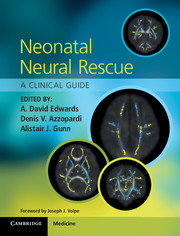Book contents
- Frontmatter
- Contents
- List of contributors
- Foreword
- Section 1 Scientific background
- 1 Neurological outcome after perinatal asphyxia at term
- 2 Molecular mechanisms of neonatal brain injury and neural rescue
- 3 The discovery of hypothermic neural rescue therapy for perinatal hypoxic–ischaemic encephalopathy
- 4 Clinical trials of hypothermic neural rescue
- 5 Economic evaluation of hypothermic neural rescue
- Section 2 Clinical neural rescue
- Section 3 The future
- Index
- References
2 - Molecular mechanisms of neonatal brain injury and neural rescue
from Section 1 - Scientific background
Published online by Cambridge University Press: 05 March 2013
- Frontmatter
- Contents
- List of contributors
- Foreword
- Section 1 Scientific background
- 1 Neurological outcome after perinatal asphyxia at term
- 2 Molecular mechanisms of neonatal brain injury and neural rescue
- 3 The discovery of hypothermic neural rescue therapy for perinatal hypoxic–ischaemic encephalopathy
- 4 Clinical trials of hypothermic neural rescue
- 5 Economic evaluation of hypothermic neural rescue
- Section 2 Clinical neural rescue
- Section 3 The future
- Index
- References
Summary
Introduction
Perinatal brain injury is a common cause of life-long neurological deficits and there is an urgent need to better understand its pathophysiology and to find strategies for prevention and treatment. The etiology is complex and multifactorial but hypoxia–ischaemia (HI), infection/inflammation and excitotoxicity (see below) are considered important causes or precipitating insults of preventable/treatable forms of perinatal brain injury. In this review, we will focus on mechanisms of brain injury in response to acute sterile insults in the developing brain that occur in term (e.g., neonatal encephalopathy) or preterm infants.
Genetic background, developmental age, sex and brain maturity affect vulnerability and the mechanisms of brain injury [1,2]. Furthermore, antecedents such as infection/inflammation, intrauterine growth restriction or pre-exposures to hypoxia can modulate brain vulnerability in response to acute insults [3–5]. Brain injury evolves over time and different mechanisms are critical during the primary, secondary and tertiary phases (Figure 2.1). Indeed, recent experimental data suggest that interventions can be effective if administered hours, days or even weeks after the primary insult [6,7].
- Type
- Chapter
- Information
- Neonatal Neural RescueA Clinical Guide, pp. 16 - 32Publisher: Cambridge University PressPrint publication year: 2013
References
- 1
- Cited by



